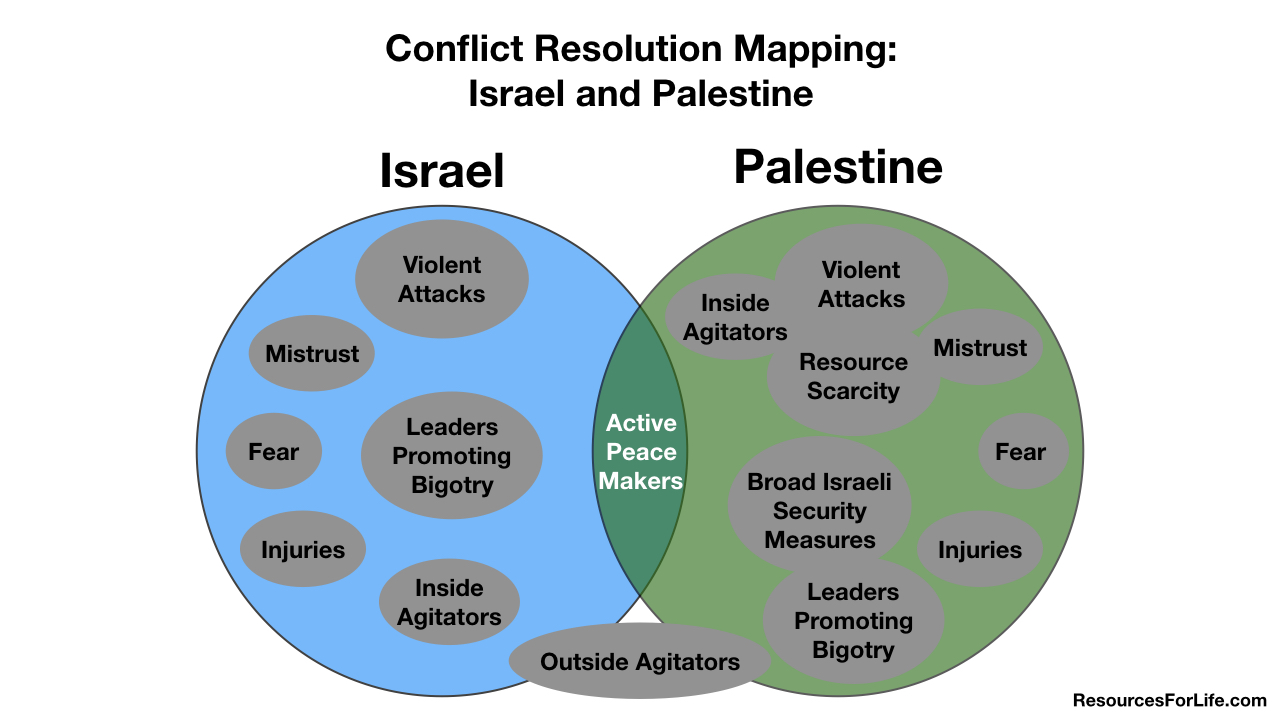Conflict Resolution Mapping is a process used to identify blockages to successful conflict resolution. Influences that facilitate or hinder reconciliation are identified and visualized for discussing a strategy for progress.
When we apply conflict resolution mapping to study the peace process in Israel and Palestine, we can see the influencers that hinder or help peace efforts.
In the map below, we can see that Israelis and Palestinians have legitimate fears and biases based on past incidents of violence as well as the fear and mistrust that comes from biased reports in media and statements by leaders.

Here are some other observations visualized in the map above:
- Broad Israeli Security Measures. Palestinians may feel frustration, anger, oppression, and resentment from the broad Israeli security measures that impede daily life for all Palestinians.
- Injuries. If someone has been harmed or lost loved ones as a result of military action or other violent acts, that person will have a lack of trust.
- Inside Agitators. There are organized groups of agitators, sometimes fueled by vengeance and retaliation, who work to create more tension and initiate violent attacks of the other group.
- Outside Agitators. These are individuals and organizations with a desire to create instability and promote violence for political, religious, or economic reasons. They may influence both sides of the conflict as well as supporting inside agitators.
- Resource Scarcity. As settlements expand and Israelis take more land in the area, this can create tension among Palestinians who feel their land and communities are being encroached upon. As land becomes more scarce, this creates tension. Also, limited access to water and other local necessities will create animosity and tension.
As shown in the map above, there are individuals and groups actively working to promote peaceful outcomes. Some small percentage of Israelis and Palestinians are working together to have a positive influence. A larger number of people want peace, but aren’t actively working toward it. They simply want to live their daily lives. A small percentage of people are agitators working to promote mistrust, hatred, and acts of retaliation. So, these are the forces at work.
A common misconception is to believe that only the people on our side are working toward peace, or at least not creating conflict. This is because the news sources we rely on only promote positive news about the group we belong to, and they report negative news about members of the other group who are engaged in acts of violence. So we’re left with this impression that we’re not to blame for ongoing conflicts, but instead it’s the other group that’s responsible. They attack, and we retaliate to defend ourselves. Viewing the visual representations in the map helps people identify commonalities on both sides, and see how good people on each side may be actively working toward peace even while agitators are trying to hinder progress.
Advanced mapping would attempt to have the map elements be visually representative of the size, percentage, significance, or relative impact of each element.
As you look at the map above, consider the blockages to be like kidney stones that need to be reduced in size and removed or otherwise addressed and dealt with. These negative influences and hinderances float around in society and alter the overall collective attitudes that dominate a society.
The video below from the “Women Wage Peace” initiative shows Palestinian women and Israeli women marching together and actively working toward peace in the region.
Feedback and Comments
Your comments posted below will shape the above article. Provide corrections, additions, or suggestions for improvement and they will most likely be incorporated above. Thanks!